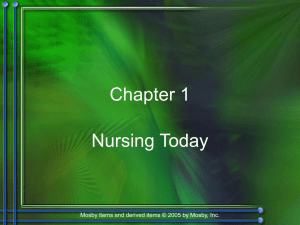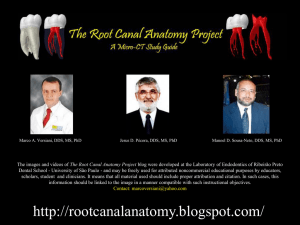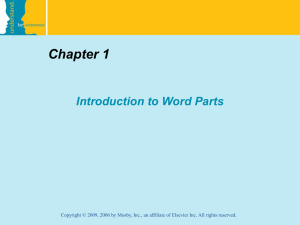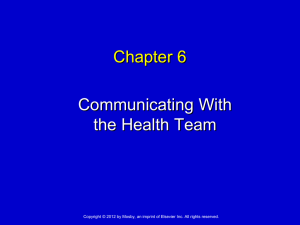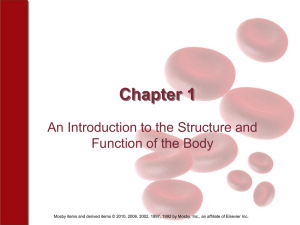Adult Health Nursing
advertisement
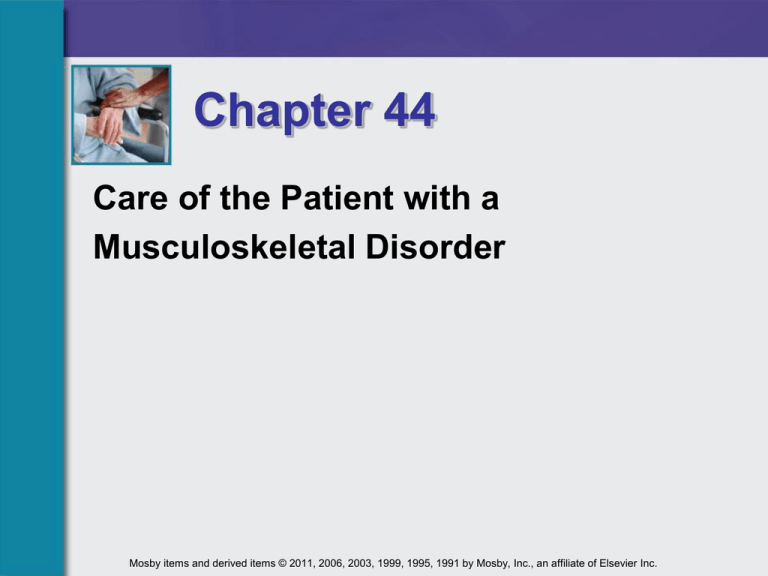
Chapter 44 Care of the Patient with a Musculoskeletal Disorder Mosby items and derived items © 2011, 2006, 2003, 1999, 1995, 1991 by Mosby, Inc., an affiliate of Elsevier Inc. Overview of Anatomy and Physiology • Functions of the skeletal system Support Protection Movement Mineral storage Hemopoiesis • Structure of bones Four classifications based on form and shape • Long, short, flat, and irregular Mosby items and derived items © 2011, 2006, 2003, 1999, 1995, 1991 by Mosby, Inc., an affiliate of Elsevier Inc. Slide 2 Figure 44-2 (From Thibodeau, G.A., Patton, K.T. [2005]. The human body in health and disease. [4th ed.]. St. Louis: Mosby.) Skeleton, anterior view. Mosby items and derived items © 2011, 2006, 2003, 1999, 1995, 1991 by Mosby, Inc., an affiliate of Elsevier Inc. Slide 3 Figure 44-3 (From Thibodeau, G.A., Patton, K.T. [2005]. The human body in health and disease. [4th ed.]. St. Louis: Mosby.) Skeleton, posterior view. Mosby items and derived items © 2011, 2006, 2003, 1999, 1995, 1991 by Mosby, Inc., an affiliate of Elsevier Inc. Slide 4 Overview of Anatomy and Physiology • Articulations (joints) Allow movement Three types according to degree of movement • Synarthrosis—no movement • Amphiarthrosis—slight movement • Diarthrosis—free movement • Divisions of the skeleton Axial skeleton Appendicular skeleton Mosby items and derived items © 2011, 2006, 2003, 1999, 1995, 1991 by Mosby, Inc., an affiliate of Elsevier Inc. Slide 5 Figure 44-1 (From Thibodeau, G.A., Patton, K.T. [2008]. Structure and function of the body. [13th ed.]. St. Louis: Mosby.) Structure of a freely movable (diarthrotic) joint. Mosby items and derived items © 2011, 2006, 2003, 1999, 1995, 1991 by Mosby, Inc., an affiliate of Elsevier Inc. Slide 6 Overview of Anatomy and Physiology • Functions of the muscular system Motion Maintenance of posture Production of heat • Skeletal muscle structure Epimysium Perimysium Endomysium Mosby items and derived items © 2011, 2006, 2003, 1999, 1995, 1991 by Mosby, Inc., an affiliate of Elsevier Inc. Slide 7 Figure 44-5 (From Thibodeau, G.A., Patton, K.T. [2005]. The human body in health and disease. [4th ed.]. St. Louis: Mosby.) Anterior view of the body. Mosby items and derived items © 2011, 2006, 2003, 1999, 1995, 1991 by Mosby, Inc., an affiliate of Elsevier Inc. Slide 8 Figure 44-6 (From Thibodeau, G.A., Patton, K.T. [2005]. The human body in health and disease. [4th ed.]. St. Louis: Mosby.) Posterior view of the body. Mosby items and derived items © 2011, 2006, 2003, 1999, 1995, 1991 by Mosby, Inc., an affiliate of Elsevier Inc. Slide 9 Overview of Anatomy and Physiology • Nerve and blood supply Blood vessels provide a constant supply of oxygen and nutrition, and nerve cells/fibers supply a constant source of information • Muscle contraction Muscle stimulus—when a muscle cell is adequately stimulated, it will contract Muscle tone—skeletal muscles are in a constant state of readiness for action Types of body movements—flexion, extension, abduction, adduction, rotation, supination, pronation, dorsiflexion, and plantar flexion Mosby items and derived items © 2011, 2006, 2003, 1999, 1995, 1991 by Mosby, Inc., an affiliate of Elsevier Inc. Slide 10 Laboratory and Diagnostic Examinations • Radiographic studies Myelogram Nuclear scanning Magnetic resonance imaging (MRI) Computed axial tomography (CT or CAT scan) Bone scan • Endoscopic examination Arthroscopy Endoscopic spinal microsurgery Mosby items and derived items © 2011, 2006, 2003, 1999, 1995, 1991 by Mosby, Inc., an affiliate of Elsevier Inc. Slide 11 Laboratory and Diagnostic Examinations • Aspiration Synovial fluid aspiration • Electrographic procedure Electromyogram (EMG) • Laboratory tests Calcium Erythrocyte sedimentation rate (ESR) Lupus erythematosus (LE) preparation Rheumatoid factor (RF) Uric acid (blood) Mosby items and derived items © 2011, 2006, 2003, 1999, 1995, 1991 by Mosby, Inc., an affiliate of Elsevier Inc. Slide 12 Inflammatory Disorders of the Musculoskeletal System • Rheumatoid arthritis Etiology/pathophysiology • • • • • Most serious form of arthritis Chronic, systemic disease Most common in women of childbearing age Autoimmune disorder, but may also be genetic May affect lungs, heart, blood vessels, muscles, eyes, and skin • Chronic inflammation of the synovial membrane of the diarthrodial joints (movable) Mosby items and derived items © 2011, 2006, 2003, 1999, 1995, 1991 by Mosby, Inc., an affiliate of Elsevier Inc. Slide 13 Inflammatory Disorders of the Musculoskeletal System • Rheumatoid arthritis (continued) Clinical manifestations/assessment • • • • • • • Characterized by periods of remission and exacerbation Malaise Muscle weakness Loss of appetite Generalized aching Edema and tenderness of joints Limited range of motion (morning stiffness) Mosby items and derived items © 2011, 2006, 2003, 1999, 1995, 1991 by Mosby, Inc., an affiliate of Elsevier Inc. Slide 14 Figure 44-7 (From Kamal, A., Brocklehurst, J.C. [1991]. Color atlas of geriatric medicine. [2nd ed.]. St. Louis: Mosby.) Rheumatoid arthritis of hands. Mosby items and derived items © 2011, 2006, 2003, 1999, 1995, 1991 by Mosby, Inc., an affiliate of Elsevier Inc. Slide 15 Inflammatory Disorders of the Musculoskeletal System • Rheumatoid arthritis (continued) Diagnostic tests • Radiography studies show loss of articular cartilage and change in bone structure • Laboratory tests Erythrocyte sedimentation rate (ESR) Rheumatoid factor (RF) Latex agglutination test Synovial fluid aspiration Mosby items and derived items © 2011, 2006, 2003, 1999, 1995, 1991 by Mosby, Inc., an affiliate of Elsevier Inc. Slide 16 Inflammatory Disorders of the Musculoskeletal System • Rheumatoid arthritis (continued) Medical management/nursing interventions • Pharmacological management • • • • Salicylates, NSAIDs, COX-2 inhibitors, anti-inflammatory agents, disease-modifying antirheumatoid drugs Rest: 8 to 10 hours of sleep a night Exercise: Range of motion two to three times per day Heat: Hot packs, heat lamp, and/or hot paraffin Rehabilitation Mosby items and derived items © 2011, 2006, 2003, 1999, 1995, 1991 by Mosby, Inc., an affiliate of Elsevier Inc. Slide 17 Inflammatory Disorders of the Musculoskeletal System • Ankylosing spondylitis Etiology/pathophysiology • Chronic, progressive disorder of the sacroiliac and hip joints, the synovial joints of the spine, and the adjacent soft tissues • Most common in young men • Strong hereditary tendency Clinical manifestations/assessment • Pain and stiffness in back; decreased ROM • Elevated temperature; tachycardia; hyperpnea Mosby items and derived items © 2011, 2006, 2003, 1999, 1995, 1991 by Mosby, Inc., an affiliate of Elsevier Inc. Slide 18 Inflammatory Disorders of the Musculoskeletal System • Ankylosing spondylitis (continued) Diagnostic tests • Hemoglobin, hematocrit, ESR, alkaline phosphatase • Radiographic Medical management/nursing interventions • Pharmacological management • • • • Analgesics, NSAIDs Exercise program: swimming and walking Surgery: replace fused joints Maintain spine alignment Turn, position, and breathing exercises every 2 hours Mosby items and derived items © 2011, 2006, 2003, 1999, 1995, 1991 by Mosby, Inc., an affiliate of Elsevier Inc. Slide 19 Inflammatory Disorders of the Musculoskeletal System • Osteoarthritis (degenerative joint disease) Etiology/pathophysiology • Nonsystemic, noninflammatory disorder that progressively causes bones and joints to degenerate • Primary Cause is unknown • Secondary Caused by trauma, infections, previous fractures, rheumatoid arthritis, stress on weight-bearing joints Mosby items and derived items © 2011, 2006, 2003, 1999, 1995, 1991 by Mosby, Inc., an affiliate of Elsevier Inc. Slide 20 Figure 44-9 (From Kamal, A., Brocklehurst, J.C. [1991]. Color atlas of geriatric medicine. [2nd ed.]. St. Louis: Mosby.) Heberden’s nodes. Mosby items and derived items © 2011, 2006, 2003, 1999, 1995, 1991 by Mosby, Inc., an affiliate of Elsevier Inc. Slide 21 Inflammatory Disorders of the Musculoskeletal System • Osteoarthritis (degenerative joint disease) (continued) Clinical manifestations/assessment • Joint edema, tenderness, instability, and deformity • Heberden’s nodes • Bouchard’s nodes Diagnostic tests • • • • Radiographic studies Arthroscopy Synovial fluid examination Bone scans Mosby items and derived items © 2011, 2006, 2003, 1999, 1995, 1991 by Mosby, Inc., an affiliate of Elsevier Inc. Slide 22 Inflammatory Disorders of the Musculoskeletal System • Osteoarthritis (degenerative joint disease) (continued) Medical management/nursing interventions • Pharmacological management • • • • Salicylates, NSAIDs, corticosteroids, glucosamine supplements Exercise balanced with rest Heat applications Gait enhancers (canes, walkers, etc.) Surgery Osteotomy Joint replacement Mosby items and derived items © 2011, 2006, 2003, 1999, 1995, 1991 by Mosby, Inc., an affiliate of Elsevier Inc. Slide 23 Inflammatory Disorders of the Musculoskeletal System • Gout (gouty arthritis) Etiology/pathophysiology • Metabolic disease resulting from an accumulation of uric acid in the blood • Caused by an ineffective metabolism of purines • Primary: hereditary factors • Secondary: use of certain drugs, complication of other diseases, or idiopathic • Affects men more frequently than women • Does not occur before puberty in males or before menopause in females Mosby items and derived items © 2011, 2006, 2003, 1999, 1995, 1991 by Mosby, Inc., an affiliate of Elsevier Inc. Slide 24 Inflammatory Disorders of the Musculoskeletal System • Gout (gouty arthritis) (continued) Clinical manifestations/assessment • • • • Excruciating pain Edema Inflammation (most common in the great toe) Tophi Diagnostic tests • Serum and uric acid level, CBC, ESR • Radiography studies • Synovial fluid aspiration Mosby items and derived items © 2011, 2006, 2003, 1999, 1995, 1991 by Mosby, Inc., an affiliate of Elsevier Inc. Slide 25 Inflammatory Disorders of the Musculoskeletal System • Gout (gouty arthritis) (continued) Medical management/nursing interventions • Pharmacological management • • • • Colchicine, phenylbutazone (Butazolidin), indomethacin (Indocin), corticosteroids, allopurinol (Zyloprim), sulfinpyrazone (Anturane) Encourage fluid intake Monitor intake and output Bed rest and joint immobilization Dietary restrictions Mosby items and derived items © 2011, 2006, 2003, 1999, 1995, 1991 by Mosby, Inc., an affiliate of Elsevier Inc. Slide 26 Other Disorders of the Musculoskeletal System • Osteoporosis Etiology/pathophysiology • Reduction of bone mass • Most common in women ages 55 to 65 • Contributing factors: immobilization; steroids; high intake of caffeine; diet low in calcium, high in protein; smoking; sedentary lifestyle Clinical manifestations/assessment • Backache • Porous and brittle bones • Dowager’s hump Mosby items and derived items © 2011, 2006, 2003, 1999, 1995, 1991 by Mosby, Inc., an affiliate of Elsevier Inc. Slide 27 Other Disorders of the Musculoskeletal System • Osteoporosis (continued) Diagnostic tests • CBC, serum calcium, phosphorus, alkaline phosphatase, blood urea nitrogen, creatinine level, urinalysis, liver and thyroid function tests • Radiography studies Medical management/nursing interventions • Pharmacological management Calcium supplements, vitamin D Estrogen, alendronate (Fosamax) • Weight-bearing exercises • Dietary recommendations Mosby items and derived items © 2011, 2006, 2003, 1999, 1995, 1991 by Mosby, Inc., an affiliate of Elsevier Inc. Slide 28 Other Disorders of the Musculoskeletal System • Osteomyelitis Etiology/pathophysiology • Local or generalized infection of the bone and bone marrow • Staphylococci are the most common cause • Introduced through trauma (injury or surgery) or via the bloodstream from another site in the body to the bone • Bacteria invade the bone and degeneration of bone occurs Mosby items and derived items © 2011, 2006, 2003, 1999, 1995, 1991 by Mosby, Inc., an affiliate of Elsevier Inc. Slide 29 Other Disorders of the Musculoskeletal System • Osteomyelitis (continued) Clinical manifestations/assessment • Persistent, severe, and increasing bone pain • Wound draining purulent fluid • Signs and symptoms of infection: temperature, tachycardia, and tachypnea • Edema of affected area Diagnostic tests • Radiography studies; bone scan • CBC; ESR; cultures of blood and drainage Mosby items and derived items © 2011, 2006, 2003, 1999, 1995, 1991 by Mosby, Inc., an affiliate of Elsevier Inc. Slide 30 Other Disorders of the Musculoskeletal System • Osteomyelitis (continued) Medical management/nursing interventions • Pharmacological management Antibiotic therapy • Surgery: removal of necrotic bone • Absolute rest of affected extremity • Wound care Irrigate with hydrogen peroxide or antibiotic solution; cover with sterile dressing • Drainage and secretion precautions • Dietary recommendations: high in calories, protein, and vitamins Mosby items and derived items © 2011, 2006, 2003, 1999, 1995, 1991 by Mosby, Inc., an affiliate of Elsevier Inc. Slide 31 Other Disorders of the Musculoskeletal System • Fibromyalgia syndrome (FMS) Etiology/pathophysiology • Musculoskeletal chronic pain syndrome • Unknown etiology Clinical manifestations/assessment • • • • • Generalized aching Irritable bowel syndrome Tension headache Paresthesia of upper extremities Sensation of edematous hands Mosby items and derived items © 2011, 2006, 2003, 1999, 1995, 1991 by Mosby, Inc., an affiliate of Elsevier Inc. Slide 32 Other Disorders of the Musculoskeletal System • Fibromyalgia syndrome (FMS) (continued) Diagnostic tests • No specific laboratory or radiographic tests diagnose FMS Medical management/nursing interventions • Pharmacological management Tricyclic antidepressants • Patient education and reassurance • Exercise • Relaxation techniques Mosby items and derived items © 2011, 2006, 2003, 1999, 1995, 1991 by Mosby, Inc., an affiliate of Elsevier Inc. Slide 33 Surgical Interventions for Total Knee or Total Hip Replacement • Knee arthroplasty (total knee replacement) Replacement of the knee joint Restore motion of the joint, relieve pain, or correct deformity • Hip arthroplasty (total hip replacement) Replacement of the hip joint Mosby items and derived items © 2011, 2006, 2003, 1999, 1995, 1991 by Mosby, Inc., an affiliate of Elsevier Inc. Slide 34 Figure 44-11 (from Monahan, F.D., et al. [2007]. Phipps’ medical-surgical nursing: health and illness perspectives. [8th ed.]. St. Louis: Mosby.) A, Tibial and femoral components of total knee prosthesis. B, Total knee prosthesis in place. Mosby items and derived items © 2011, 2006, 2003, 1999, 1995, 1991 by Mosby, Inc., an affiliate of Elsevier Inc. Slide 35 Figure 44-14 Hip arthroplasty (total hip replacement). Mosby items and derived items © 2011, 2006, 2003, 1999, 1995, 1991 by Mosby, Inc., an affiliate of Elsevier Inc. Slide 36 Surgical Interventions for Total Knee or Total Hip Replacement • Arthroplasty Nursing interventions • Intake and output Drainage from operative drains Oral and intravenous intake Urinary output • Promote respiratory function • • • • Give oxygen 2 to 3 L/min Incentive spirometer; cough and deep-breathe Bed rest for 24 to 48 hours Change dressing as ordered Diet as ordered Neurovascular checks and vital signs every 4 hours Mosby items and derived items © 2011, 2006, 2003, 1999, 1995, 1991 by Mosby, Inc., an affiliate of Elsevier Inc. Slide 37 Surgical Interventions for Total Knee or Total Hip Replacement • Arthroplasty (continued) Nursing interventions (continued) • Physical therapy will initiate ambulation and prescribe routine • Antiembolisim stockings • Avoid dislocation of prosthesis Avoid adduction and hyperflexion of hip Use toilet riser to prevent hyperflexion of hip Mosby items and derived items © 2011, 2006, 2003, 1999, 1995, 1991 by Mosby, Inc., an affiliate of Elsevier Inc. Slide 38 Fractures • Fracture of the hip Etiology/pathophysiology • Most common type of fracture • Women at higher risk due to osteoporosis • Types: intracapsular and extracapsular Clinical manifestations/assessment • Severe pain at site • Inability to move the leg voluntarily • Shortening or external rotation of the leg Mosby items and derived items © 2011, 2006, 2003, 1999, 1995, 1991 by Mosby, Inc., an affiliate of Elsevier Inc. Slide 39 Figure 44-16 (from Monahan, F.D., et al. [2007]. Phipps’ medical-surgical nursing: health and illness perspectives. [8th ed.]. St. Louis: Mosby. Fractures of the hip. Mosby items and derived items © 2011, 2006, 2003, 1999, 1995, 1991 by Mosby, Inc., an affiliate of Elsevier Inc. Slide 40 Fractures • Fracture of the hip (continued) Diagnostic tests • Radiographic examination • Hemoglobin Medical management/nursing interventions • Buck’s or Russell’s traction until surgery • Surgical repair Internal fixation Neufeld nail and screws, Kuntscher nail Prosthetic implants o Austin Moore prosthesis, bipolar hip replacement Mosby items and derived items © 2011, 2006, 2003, 1999, 1995, 1991 by Mosby, Inc., an affiliate of Elsevier Inc. Slide 41 Fractures • Fracture of the hip (continued) Medical management/nursing interventions (continued) • Postoperative interventions Wound and drain assessment Vital signs Incentive spirometer and turning every 2 hours Antiembolic stockings; anticoagulation therapy Maintain leg abduction Limit weight-bearing on affected side Chairs and commode seats should be raised to prevent flexion of hip beyond 60 degrees Mosby items and derived items © 2011, 2006, 2003, 1999, 1995, 1991 by Mosby, Inc., an affiliate of Elsevier Inc. Slide 42 Fractures • Fracture of the hip (continued) Medical management/nursing interventions (continued) • Patient teaching for open reduction internal fixation (ORIF) Assess ability to understand Assist to dangle at bedside No weight on operative side Turn every 2 hours, maintain abduction Physical therapy will instruct as to ambulation and weight-bearing As patient progresses, encourage continuing ambulation only with assistance Mosby items and derived items © 2011, 2006, 2003, 1999, 1995, 1991 by Mosby, Inc., an affiliate of Elsevier Inc. Slide 43 Fractures • Fracture of the hip (continued) Medical management/nursing interventions (continued) • Patient teaching for hip prosthetic implant Avoid hip flexion beyond 60 degrees for approximately 10 days; beyond 90 degrees for 2 to 3 months Avoid adduction of the affected leg beyond midline for 2 to 3 months (maintain abduction) Maintain partial weight-bearing for approximately 2 to 3 months Avoid positioning on the operative side Mosby items and derived items © 2011, 2006, 2003, 1999, 1995, 1991 by Mosby, Inc., an affiliate of Elsevier Inc. Slide 44 Fractures • Other fractures Etiology/pathophysiology • A traumatic injury to a bone in which the continuity of the tissue of the bone is broken • Pathological or spontaneous fractures • Types of fractures: open, closed, greenstick, complete, comminuted, impacted, transverse, oblique, spiral, Colle’s, and Pott’s Mosby items and derived items © 2011, 2006, 2003, 1999, 1995, 1991 by Mosby, Inc., an affiliate of Elsevier Inc. Slide 45 Fractures • Other fractures (continued) Clinical manifestations/assessment • • • • • • • • • Pain Loss of normal function Obvious deformity Change in the curvature or length of bone Crepitus (grating sound with movement) Soft tissue edema Warmth over injured area Ecchymosis of skin surrounding injured area Loss of sensation distal to injury Mosby items and derived items © 2011, 2006, 2003, 1999, 1995, 1991 by Mosby, Inc., an affiliate of Elsevier Inc. Slide 46 Fractures • Other fractures (continued) Diagnostic tests • Radiographic examination Medical management/nursing interventions • • • • • • • Splinting to prevent edema Body alignment Elevation of body part Application of cold packs, first 24 hours Administration of analgesics Assess for change in color, sensation, or temperature Observe for signs of shock Mosby items and derived items © 2011, 2006, 2003, 1999, 1995, 1991 by Mosby, Inc., an affiliate of Elsevier Inc. Slide 47 Fractures • Other fractures (continued) Medical management/nursing interventions (continued) • Closed (simple) Closed reduction; immobilization; traction Open reduction with internal fixation device • Open (compound) Surgical debridement and culture of wound Administration of tetanus toxoid Observation for signs of infection Closure of wound Reduction and immobilization of fracture Mosby items and derived items © 2011, 2006, 2003, 1999, 1995, 1991 by Mosby, Inc., an affiliate of Elsevier Inc. Slide 48 Fractures • Fracture of the vertebrae Etiology/pathophysiology • • • • • • Diving accidents Blows to the head or body Osteoporosis Metastatic cancer Motorcycle and car accidents Displaced fracture may place pressure on or sever the spinal cord nerves Mosby items and derived items © 2011, 2006, 2003, 1999, 1995, 1991 by Mosby, Inc., an affiliate of Elsevier Inc. Slide 49 Fractures • Fracture of the vertebrae (continued) Clinical manifestations/assessment • Pain at site of injury • Partial or complete loss of mobility or sensation • Evidence of fracture/fracture dislocation on x-ray Medical management/nursing interventions • Stable injuries Pain medication, muscle relaxants Back support, brace, or cast • Unstable fractures Traction, open reduction Mosby items and derived items © 2011, 2006, 2003, 1999, 1995, 1991 by Mosby, Inc., an affiliate of Elsevier Inc. Slide 50 Fractures • Fracture of the pelvis Etiology/pathophysiology • Falls, automobile accidents, crushing accidents Clinical manifestations/assessment • Unable to bear weight without discomfort • Pelvic tenderness and edema • Signs of shock Medical management/nursing interventions • Bed rest—More severe fractures may require surgery and/or spica or body cast Mosby items and derived items © 2011, 2006, 2003, 1999, 1995, 1991 by Mosby, Inc., an affiliate of Elsevier Inc. Slide 51 Complications of Fractures • Compartment syndrome Cause • Progressive development of arterial vessel compression and reduced blood supply to an extremity Clinical manifestations/assessment • Sharp pain with movement, numbness or tingling in the affected extremity, cool and pale or cyanotic, slow capillary refill Medical management/nursing interventions • Fasciotomy (incision into the fascia) Mosby items and derived items © 2011, 2006, 2003, 1999, 1995, 1991 by Mosby, Inc., an affiliate of Elsevier Inc. Slide 52 Figure 44-26 (From Beare, P.G., Myers, J.L. [1998]. Adult health nursing. [3rd ed.]. St. Louis: Mosby.) Compartment syndrome. Mosby items and derived items © 2011, 2006, 2003, 1999, 1995, 1991 by Mosby, Inc., an affiliate of Elsevier Inc. Slide 53 Complications of Fractures • Shock Cause • Blood loss, pain, fear Clinical manifestations/assessment • Altered level of consciousness, restlessness • Hypotension, tachycardia, and tachypnea • Pale, cool, moist skin Medical management/nursing interventions • Restore blood volume; shock trousers • Oxygen Mosby items and derived items © 2011, 2006, 2003, 1999, 1995, 1991 by Mosby, Inc., an affiliate of Elsevier Inc. Slide 54 Complications of Fractures • Fat embolism Cause • Embolization of fat tissue with platelets Clinical manifestations/assessment • Irritability, restlessness,disorientation, stupor, coma, chest pain, and dyspnea Medical management/nursing interventions • IV fluids • Steroids, digoxin • Oxygen Mosby items and derived items © 2011, 2006, 2003, 1999, 1995, 1991 by Mosby, Inc., an affiliate of Elsevier Inc. Slide 55 Complications of Fractures • Gas gangrene Cause • Infection of skeletal muscle by Clostridium Clinical manifestations/assessment • Pain at site of injury • Signs of infection; gas bubbles under the skin • Necrotic skin at site; foul odor from wound Medical management/nursing interventions • Excision of gangrenous tissue • Antibiotics; strict aseptic technique Mosby items and derived items © 2011, 2006, 2003, 1999, 1995, 1991 by Mosby, Inc., an affiliate of Elsevier Inc. Slide 56 Complications of Fractures • Thromboembolus Cause • Blood vessel is occluded by an embolus Clinical manifestations/assessment • Area tingles and is cold, numb, and cyanotic • Pulmonary embolus causes a sharp thoracic pain Medical management/nursing interventions • Anticoagulants Mosby items and derived items © 2011, 2006, 2003, 1999, 1995, 1991 by Mosby, Inc., an affiliate of Elsevier Inc. Slide 57 Complications of Fractures • Delayed fracture healing Healing is delayed but will eventually occur • Nonunion The ends of the fracture fail to stabilize and heal after 6 to 9 months Mosby items and derived items © 2011, 2006, 2003, 1999, 1995, 1991 by Mosby, Inc., an affiliate of Elsevier Inc. Slide 58 Skeletal Fixation Devices • External fixation devices Skeletal pin external fixation • Immobilizes fractures by the use of pins inserted through the bone and attached to a rigid external metal frame • Casts/cast brace Made of layers of plaster of Paris, fiberglass, or plastic roller bandages Stockinette applied, then a sheet of wadding, and casting material Mosby items and derived items © 2011, 2006, 2003, 1999, 1995, 1991 by Mosby, Inc., an affiliate of Elsevier Inc. Slide 59 Nonsurgical Interventions for Musculoskeletal Disorders • Traction The process of putting an extremity, bone, or group of muscles under tension by means of weights and pulleys to: • • • • • Align and stabilize a fracture site Relieve pressure on nerves Maintain correct positioning Prevent deformities Relieve muscle spasms Skeletal or skin Mosby items and derived items © 2011, 2006, 2003, 1999, 1995, 1991 by Mosby, Inc., an affiliate of Elsevier Inc. Slide 60 Traumatic Injuries • Contusion: A blow or blunt force that causes local bleeding under the skin • Sprains: Wrenching or hyperextension of a joint • Whiplash: Injury at cervical spine caused by hyperextension • Strains: Microscopic muscle tears as a result of overstretching muscles and tendons Mosby items and derived items © 2011, 2006, 2003, 1999, 1995, 1991 by Mosby, Inc., an affiliate of Elsevier Inc. Slide 61 Traumatic Injuries • Contusions, sprains, whiplash, strains Medical management/nursing interventions • Elevate injured area • Cold compresses for 15 to 20 minutes intermittently for 12 to 36 hours • Warm compresses for 15 to 30 minutes four times a day after 24 hours • Compressive dressings and/or splint • Surgery Mosby items and derived items © 2011, 2006, 2003, 1999, 1995, 1991 by Mosby, Inc., an affiliate of Elsevier Inc. Slide 62 Traumatic Injuries • Dislocations Etiology/pathophysiology • Temporary displacement of bones from their normal position Clinical manifestations/assessment • • • • • Erythema; discoloration Edema Pain Limitation of movement Deformity or shortening of the extremity Mosby items and derived items © 2011, 2006, 2003, 1999, 1995, 1991 by Mosby, Inc., an affiliate of Elsevier Inc. Slide 63 Traumatic Injuries • Dislocations (continued) Medical management/nursing interventions • Closed reduction • Open reduction • Cold compresses first 24 hours and warm compresses after 24 hours • Elevate injured extremity • Elastic bandage • Immobilize • Analgesics Mosby items and derived items © 2011, 2006, 2003, 1999, 1995, 1991 by Mosby, Inc., an affiliate of Elsevier Inc. Slide 64 Traumatic Injuries • Carpal tunnel syndrome Etiology/pathophysiology • Compression of the median nerve between the carpal ligament and other structures • Predisposing factors Obese, middle-aged women Employment in occupations involving repetitious motions of the fingers and hands Mosby items and derived items © 2011, 2006, 2003, 1999, 1995, 1991 by Mosby, Inc., an affiliate of Elsevier Inc. Slide 65 Figure 44-38 (From Thompson, J.M., et al. [2002]. Mosby’s clinical nursing. [5th ed.]. St. Louis: Mosby.) A, Wrist structures involved in carpal tunnel syndrome. B, Decompression of median nerve. Mosby items and derived items © 2011, 2006, 2003, 1999, 1995, 1991 by Mosby, Inc., an affiliate of Elsevier Inc. Slide 66 Traumatic Injuries • Carpal tunnel syndrome (continued) Clinical manifestations/assessment • • • • • • • Paresthesia Hypoesthesia Burning pain or tingling in the hands Inability to grasp or hold small objects Edema of the hand, wrist, or fingers Muscle atrophy Depressed appearance at the base of the thumb on the palmar side Mosby items and derived items © 2011, 2006, 2003, 1999, 1995, 1991 by Mosby, Inc., an affiliate of Elsevier Inc. Slide 67 Traumatic Injuries • Carpal tunnel syndrome (continued) Diagnostic tests • Physical exam—Tinel’s sign • Electromyogram • MRI Medical management/nursing interventions • • • • • Immobilizer Elevate extremity ROM exercises Hydrocortisone injections Surgery Mosby items and derived items © 2011, 2006, 2003, 1999, 1995, 1991 by Mosby, Inc., an affiliate of Elsevier Inc. Slide 68 Traumatic Injuries • Herniation of intervertebral disk Etiology/pathophysiology • Rupture of the fibrocartilage surrounding an intervertebral disk, releasing the nucleus pulposus that cushions the vertebrae above and below • Lumbar and cervical herniations are most common • May occur from lifting, twisting, trauma, or degenerative changes Mosby items and derived items © 2011, 2006, 2003, 1999, 1995, 1991 by Mosby, Inc., an affiliate of Elsevier Inc. Slide 69 Figure 44-39 (From Thibodeau, G.A., Patton, K.T. [2005]. The human body in health and disease. [4th ed.]. St. Louis: Mosby.) Sagittal section of vertebrae showing both normal and herniated disks. Mosby items and derived items © 2011, 2006, 2003, 1999, 1995, 1991 by Mosby, Inc., an affiliate of Elsevier Inc. Slide 70 Traumatic Injuries • Herniation of intervertebral disk (continued) Clinical manifestations/assessment • Lumbar Low back pain that radiates over the buttock and numbness and tingling in affected leg • Cervical Neck pain, headache, and neck rigidity Diagnostic tests • CAT scan, myelography, and electromyelography Mosby items and derived items © 2011, 2006, 2003, 1999, 1995, 1991 by Mosby, Inc., an affiliate of Elsevier Inc. Slide 71 Traumatic Injuries • Herniation of intervertebral disk (continued) Medical management/nursing interventions • Pharmacological management • • • • Analgesics Muscle relaxants Bed rest Physical therapy Traction Surgery Laminectomy, spinal fusion, diskectomy, chemonucleolysis Mosby items and derived items © 2011, 2006, 2003, 1999, 1995, 1991 by Mosby, Inc., an affiliate of Elsevier Inc. Slide 72 Tumors • Tumors of the bone Etiology/pathophysiology • • • • May be primary or secondary Benign or malignant Osteogenic sarcoma Osteochondroma Clinical manifestations/assessment • • • • Spontaneous fractures Anemia Pain especially with weight-bearing Edema and discoloration of skin at site Mosby items and derived items © 2011, 2006, 2003, 1999, 1995, 1991 by Mosby, Inc., an affiliate of Elsevier Inc. Slide 73 Tumors • Tumors of the bone (continued) Diagnostic tests • • • • Radiography studies Bone scan; bone biopsy CBC; platelet count; serum protein levels Serum alkaline phosphatase level Medical management/nursing interventions • Surgery • Chemotherapy and radiation Mosby items and derived items © 2011, 2006, 2003, 1999, 1995, 1991 by Mosby, Inc., an affiliate of Elsevier Inc. Slide 74 Amputation • Amputation of a portion of or an entire extremity Malignant tumors, injuries, impaired circulation, congenital deformities, infections • Postoperative nursing interventions Raise foot of bed to elevate extremity Encourage movement Place in prone position at least two times a day Teach strengthening exercises Elastic wraps to shape residual extremity Assess for respiratory complications Phantom-limb pain is normal Mosby items and derived items © 2011, 2006, 2003, 1999, 1995, 1991 by Mosby, Inc., an affiliate of Elsevier Inc. Slide 75 Figure 44-40 (From Beare, P.G., Myers, J.L. [1998]. Adult health nursing. [3rd ed.]. St. Louis: Mosby.) Correct method of bandaging amputation stump. Mosby items and derived items © 2011, 2006, 2003, 1999, 1995, 1991 by Mosby, Inc., an affiliate of Elsevier Inc. Slide 76 Nursing Process • Assessment Scoliosis • Lateral curvature of the spine Kyphosis • A rounding of the thoracic spine • Hump-backed appearance Lordosis • An increase in the curve at the lumbar region Blanching test • Capillary nail refill Mosby items and derived items © 2011, 2006, 2003, 1999, 1995, 1991 by Mosby, Inc., an affiliate of Elsevier Inc. Slide 77 Nursing Process • Nursing diagnoses Mobility, impaired physical Mobility, impaired bed Coping, ineffective Anxiety Pain Knowledge, deficient Mosby items and derived items © 2011, 2006, 2003, 1999, 1995, 1991 by Mosby, Inc., an affiliate of Elsevier Inc. Slide 78
